We’ve categorized the lenses into four groups: wide-angle zoom, standard zoom, telephoto zoom and super-zoom, and round up the features and lens metric scores of the top three performers in each group.
Best wide-angle zoom: Panasonic Lumix G Vario 7-14mm f/4 ASPH
A wide-angle zoom offers focal lengths from an ultra-wide to a standard-wide field of view, making them a popular choice for landscape and architectural photos, or simply for shooting in confined spaces. We’ve tested two such lenses on the E-M1 II, including the $898 Panasonic LUMIX G VARIO 7-14mm f/4 ASPH (Panasonic 7-14mm f/4) and the $699 Olympus M.Zuiko DIGITAL ED 9-18mm f/4-5.6 (Olympus 9-18mm f/4-5.6).
With its wider 7-14mm (14-28mm equivalent) focal range, fixed f/4 maximum aperture, and built-in petal-shaped lens hood, the Panasonic wide-angle offers a little more than the Olympus 9-18mm f/4-5.6.
However, Olympus does have an alternative M.Zuiko 7-14mm f/2.8 PRO option that’s a very similar proposition to the Panasonic 7-14mm, available for $1299, but we weren’t able to analyze it in time for this review.
Scores and lens metrics are very similar for the two tested wide-angle zooms, with the Panasonic 7-14mm f/4 just ahead for low-light performance with an overall score of 19 points, compared to 18 for the Olympus 9-18mm f/4-5.6. Geometric distortion, with some noticeable barrel curvature, can be an issue for wide-angle lenses, and particularly for zooms. The Panasonic distorts slightly more at 7mm, compared to the Olympus at 9mm, with nearly 2.5% barrel curvature, but the Panasonic offers slightly straighter lines than the Olympus between 10 and 14mm.
The Olympus handles vignetting very well. It’s heaviest at 9mm f/4 as you’d expect, but with corner shading under –1EV even at this setting, and only –0.33EV between f/5.6 to f/22, it’s very respectable for a wide-angle zoom. Corner shading is bit more prevalent on the Panasonic, at almost –2Ev using f/4 at all focal lengths. It improves between f/5.6 and f/22, but expect to correct some vignetting at all settings with the Panasonic.
Both wide-angle zooms are sharper at the wider focal lengths, and the Panasonic hits peak sharpness at around 70% acutance in the field at 7mm, using apertures between f/4 and f/8, and then drops to around 60% at f/11 and to 45% at f/22.
At 14mm, the Panasonic also offers good center sharpness at around 70% acutance at f/5.6 and f/8, but it’s not quite as consistent at the edges, which drop to around 55% acutance. The range of peak sharpness on the Olympus is a little more limited, with its best results at the wider focal lengths between 7 and 11mm, using apertures between f/4 and f/5.6, where it resolves around 70% acutance. It’s a bit softer at the mid f/8 and f/11 apertures, dropping to around 60/65% acutance, and at the longer focal lengths between 14 to 18mm, it’s again sharper at the wider f/4 and f/5.6 apertures.
Best standard zoom: Olympus M.Zuiko Digital ED 12-40mm f/2.8
Standard zooms offer a wide-angle through to short-telephoto focal length in a single lens, making them a convenient choice for a range of photography types such as landscapes and portraits.
They’re good workhorse lenses for many photographers, and the typical standard zoom focal length for Micro-Four-Thirds cameras is 14-42mm, or 28-84mm in 35mm-equivalent terms.
There’s a choice of keenly-priced entry-level models, which typically feature a variable maximum aperture, as well as the more serious enthusiast or pro options that boast fixed f/2.8 maximum apertures, along with improved lens metrics and sharpness.
We’ve tested 6 standard zooms on the E-M1 II, with scores ranging from a high of 25 points on the Olympus M.Zuiko Digital ED 12-40mm f/2.8 PRO (Olympus 12-40mm f/2.8) to a low of 15 points on the Olympus M.Zuiko Digital ED 12-50mm f/3.5-6.3 EZ.
The top three include the $999 Olympus 12-40mm f/2.8 with 25 points, the $998 Panasonic Lumix G X Vario 12-35mm f/2.8 ASPH POWER OIS (Panasonic 12-35mm f/2.8) with 23 points, and the Panasonic Lumix G Vario 14-42mm f/3.5-5.6 II ASPH MEGA OIS (Panasonic 14-42mm f/3.5-5.6 II) with 18 points. The fixed fast-aperture Olympus and Panasonic versions boast better low-light performance, with around 2 TStops improved light transmission compared to the more budget-oriented Panasonic 14-42mm f/3.5-5.6 II.
For sharpness, the Panasonic and Olympus f/2.8 versions are a cut above, too, scoring 12P-Mpix each compared to 9P-Mpix for the variable-aperture Panasonic standard zoom. The Olympus 12-40mm f/2.8 performs better at the maximum f/2.8 aperture compared to the Panasonic 12-35mm f/2.8, with good uniform resolution around 70% acutance in the field between 12-25mm.
The Olympus is a little softer at 40mm f/2.8, dropping to just over 60% acutance, but remains uniform. It hits peak sharpness using apertures between f/4 and f/5.6, with over 70% acutance between 12-25mm, and slightly softer results again at 40mm. In comparison, the Panasonic 12-35mm f/2.8 isn’t uniform at f/2.8 using any focal length, but offers good center sharpness with focal lengths between 18-35mm. It also hits peak sharpness at f/4 and f/5.6 between 18-35mm, and although it’s still not truly uniform at these settings, it’s an improvement over edge sharpness at f/2.8. The Panasonic 14-42mm f/3.5-5.6 II offers good center sharpness around 70% acutance at the wider focal lengths, using wider apertures up to f/8, but it isn’t uniform and has slightly softer edges. Resolution is more uniform at the longer focal lengths between 25-42mm, but with lower acutance in the field at around 60%.
All three lenses display some noticeable barrel distortion at their wider focal lengths, with slightly more curvature on the Olympus 12-40mm f/2.8, which would benefit from some correction at all focal lengths up to 24mm. The two Panasonic standard zooms offer noticeably straighter lines in comparison at focal lengths from 18mm.
Vignetting is about the same among the three, displaying the heaviest corner shading at the wider focal lengths, using the wider aperture settings. Stopping down to f/4 on the fixed-aperture Olympus and Panasonic lenses all but eradicates the issue at all focal lengths, however, and although the Panasonic 14-42mm f/3.5-5.6 II continues to display some corner shading at all apertures at 14mm, it’s notably better between 18-42mm.
Best telephoto zoom: Panasonic Lumix G X Vario 35-100mm f/2.8 POWER OIS
A telephoto zoom is a popular second lens for many photographers looking for an optic with greater reach to get closer to the action. For the E-M1 II, there’s a range of telephoto zoom focal lengths available, including the typical 70-200mm equivalent focal length often preferred by pros and serious enthusiasts, as well as mega-zoom options, such as 45-150mm (90-300mm equivalent) or 75-300mm (150-600mm equivalent).
To keep the cost, size, and weight of the mega-zoom lenses realistic, these commonly feature a variable f/4-5.6 maximum aperture, which has an impact on performance, and notably so at the longer end of the zoom, providing less light for the E-M1 II’s EVF and autofocus system.
We have tested one fixed f/2.8 aperture option in the shape of the $1298 Panasonic Lumix G X Vario 35-100mm f/2.8 POWER OIS (Panasonic 35-100mm f/2.8), which comes out on top for low-light performance and sharpness. A couple of fixed f/2.8 alternatives are also available for the E-M1 II, such as the $1499 Olympus M.Zuiko Digital ED 40-150mm f/2.8 PRO and the $1299 Olympus M.Zuiko Digital ED 12-100mm f/4 IS PRO, which we unfortunately weren’t able to test nor include as part of this review.
We have tested a total of eight telephoto zooms on the E-M1 II, with scores ranging from a high of 23 points on the Panasonic 35-100mm f/2.8 to a low of 13 points on the Olympus M.Zuiko Digital ED 75-300mm f/4.8-6.7.
The top three include the $1298 Panasonic 35-100mm f/2.8 with 23 points, the $199 Olympus M.Zuiko Digital ED 40-150mm f/4-5.6 (Olympus 40-150mm f/4-5.6) with 19 points, and the $248 Panasonic Lumix G Vario 45-150mm f/4-5.6 ASPH MEGA OIS (Panasonic 45-150mm f/4-5.6) with 16 points.
The Panasonic 35-100mm f/2.8 offers good levels of sharpness between 60% and 70% acutance at all focal lengths using apertures between f/2.8 and f/11, with resolution that’s pretty close to uniform at many settings. Covering a greater range, the cheaper variable-aperture Olympus and Panasonic options are a little more inconsistent, with some edge softness at many settings, and their sharpest and most uniform results use focal lengths and apertures in the middle of their range (around 70-100mm at f/5.6 and f/8).
The Panasonic 35-100mm f/2.8 distorts quite heavily between 35-70mm, with some noticeable barrel curvature that would benefit from some correction for straighter lines. Both the Olympus and Panasonic variable-aperture versions are better by comparison, notably the Panasonic 45-150mm f/4-5.6, which boasts very little distortion at any focal length.
Best super-zoom: Panasonic LUMIX G VARIO 14-140mm f/3.5-5.6 ASPH OIS
A super-zoom lens is an all-in-one solution for enthusiasts after a convenient wide-angle through to long-telephoto focal length in a single lens. With such a large zoom range on offer, super zooms generally feature a variable maximum aperture such as f/4 to f/5.6, which means light transmission reduces the further you zoom in. This helps keep the size and cost of super-zooms realistic for the target market, but impacts performance, as less light reaches the EVF and autofocus sensors. We’ve tested four super-zooms on the E-M1 II, with scores ranging from a high of 17 points on the Panasonic LUMIX G VARIO 14-140mm f/3.5-5.6 ASPH OIS (Panasonic14-140mm f/3.5-5.6), to a low of 13 points on the Olympus M.Zuiko Digital ED 14-150mm f/4-5.6 II (Olympus 14-150mm f/4-5.6 II).
Ranking in third place for super zooms on the E-M1 II, the first iteration of the LUMIX G VARIO 14-140mm f/3.5-5.6 has now been replaced with the new POWER OIS model, so we’ve excluded this from our top-three analysis. The top three therefore include the $698 Panasonic 14-140mm f/3.5-5.6 with 17 points, as well as the $459 Tamron 14-150mm f/3.5-5.6 Di III VC (Tamron 14-150mm f/3.5-5.6) and the $599 Olympus 14-150mm f4-5.6 II, both with 13 points.
All three offer a similar proposition in terms of focal length and variable maximum aperture. Although the Panasonic and the Tamron super-zooms also feature lens-based optical image stabilization, these lenses don’t increase the anti-shake performance of the E-M1 II’s 5-axis sensor shift stabilization system. The $1299 Olympus M.Zuiko 12-100mm f/4 IS PRO super-zoom does increase the stabilization potential of the E-M1 II — up to a staggering 6.5 stops to enable blur-free shots with shutter speeds as slow as 2 seconds. We’re yet to test this lens, however, so it couldn’t be included in this review, but look out for an update in due course.
With the exception of sharpness, lens metrics for the top three tested super-zooms are very similar, but there are some variations on performance at different focal lengths and aperture settings. Both the Panasonic and Tamron super-zooms display heavy barrel distortion at their widest 14mm focal length. The Olympus is notably better at 14mm in comparison, and all three lenses improve between 35 and 150mm, notably the Panasonic, which is virtually free from distortion at these settings.
The heaviest vignetting occurs using all three super-zooms at their widest 14mm focal length, but with corner shading below –1EV even at these settings, it isn’t a major problem, and all are free from corner shading between 24 and 150mm.
Due to the nature of a super-zoom’s optical construction, it’s difficult to perfectly align all the wavelengths of light at all settings, and accordingly, all three display some noticeable chromatic aberration. The Panasonic is the best overall, with only some mild fringing at all aperture settings between 70-140mm, but both the Tamron and Olympus display some fairly problematic aberrations at different focal lengths, with the Tamron worse at its wider focal lengths and the Olympus worse between 50 and 150mm.
The Panasonic 14-140mm f/3.5-5.6 wins overall for sharpness, thanks to improved peak sharpness and slightly more consistent resolution across the different focal lengths and aperture settings. All three top-ranked super-zooms are sharpest at their widest 14mm focal lengths, and the Panasonic 14-140mm f/3.5-5.6 and Olympus 14-150mm f/4-5.6 are good between f/4 to f/8 at 14mm, and hit peak sharpness at 14mm f/4. The Tamron 14-150mm f/3.5-5.8 suffers a little in comparison at f/4, offering better results at 14mm between f/5.6 and f/8.
Using the longer telephoto focal lengths between 70mm and 150mm, the focal lengths enthusiasts buying a super-zoom are often most interested in, the Panasonic lens just has the edge.
The Panasonic offers good uniform resolution of around 60% acutance in the field at 70mm f/8, and although edges are a little softer at 140mm f/8, it’s still good in the center of frame. The Tamron isn’t brilliant at 140mm f/5.6, but closing down to f/8 improves things, offering uniform resolution at 70mm f/8, although acutance remains below 60%. At 150mm f/8, although good in the center third of the frame, the Tamron displays some noticeable softness in the outer field, which drops below 50% acutance. The Olympus 14-150mm isn’t truly uniform between 70-150mm using any of the mid-apertures between f/5.6 to f/11 either, so despite being good in the center, there’s noticeable drop-off in the outer field.


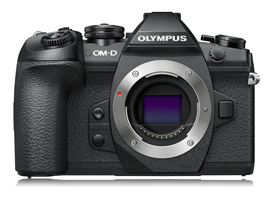

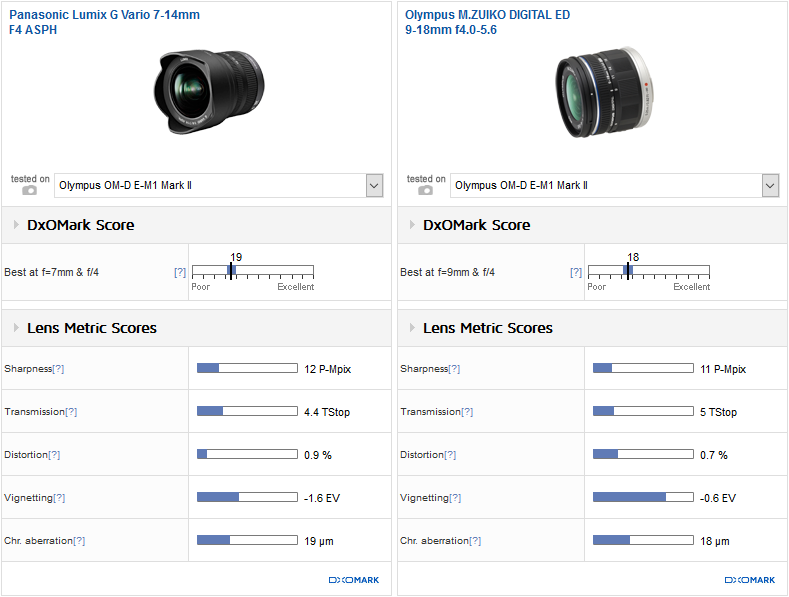
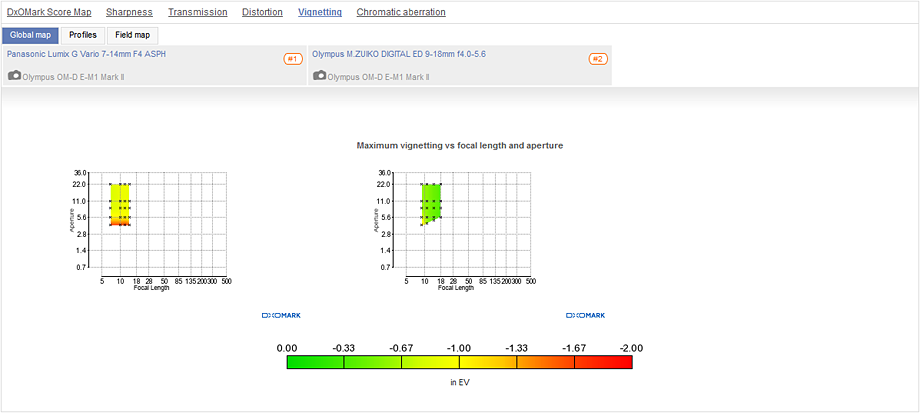
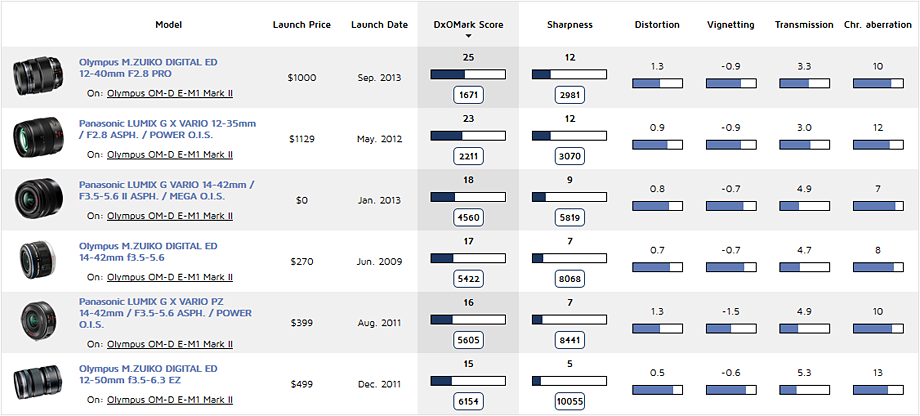
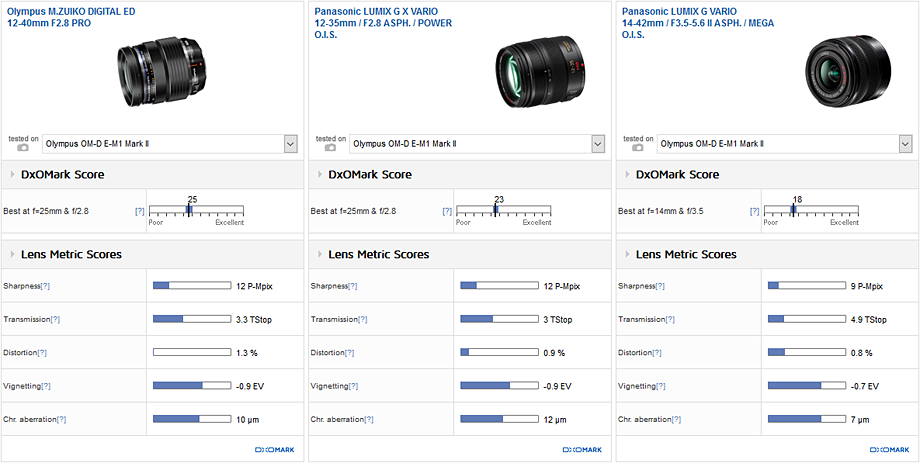
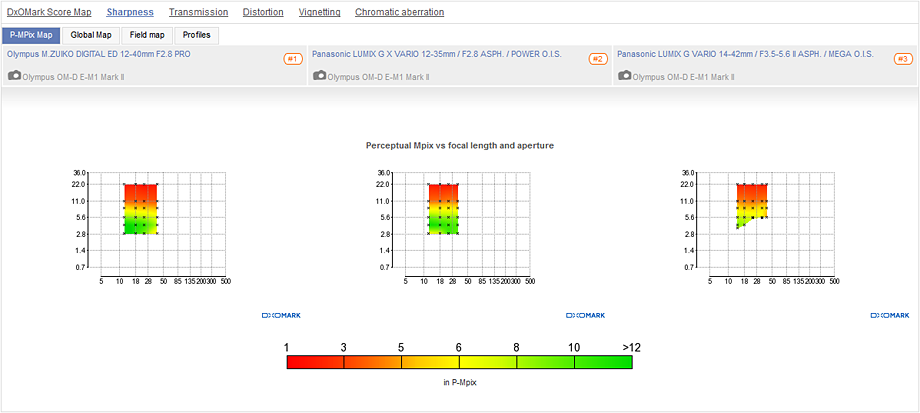
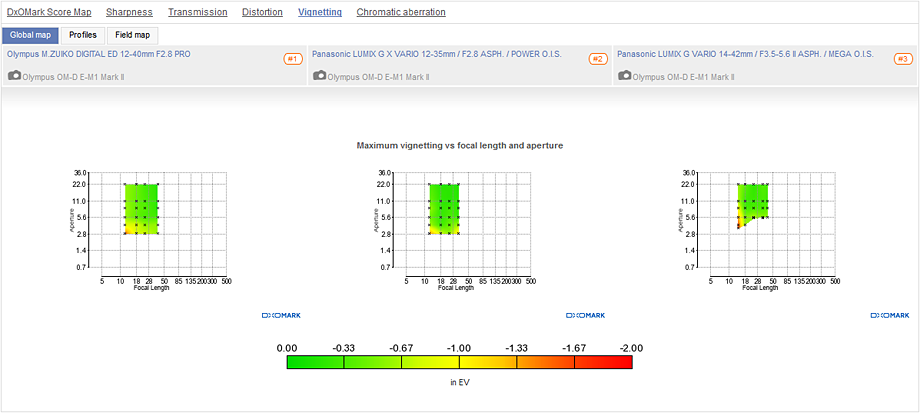
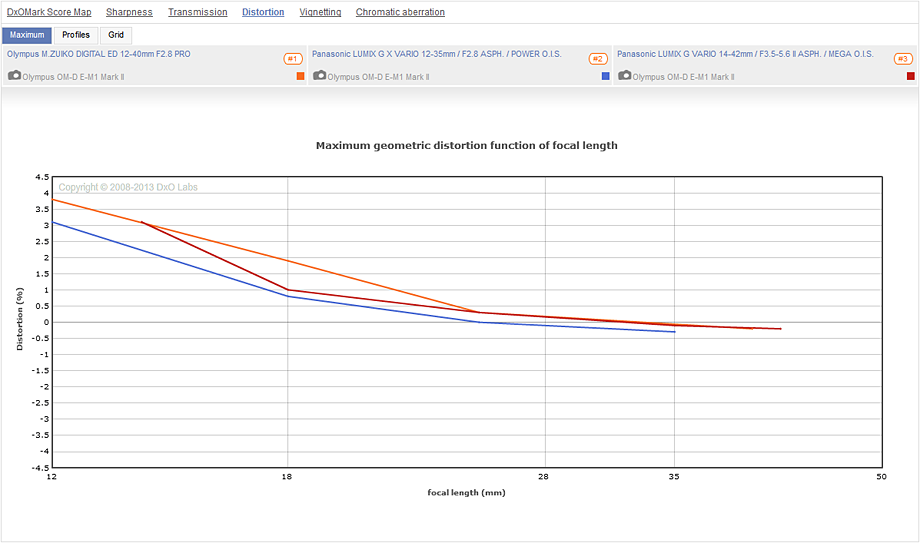
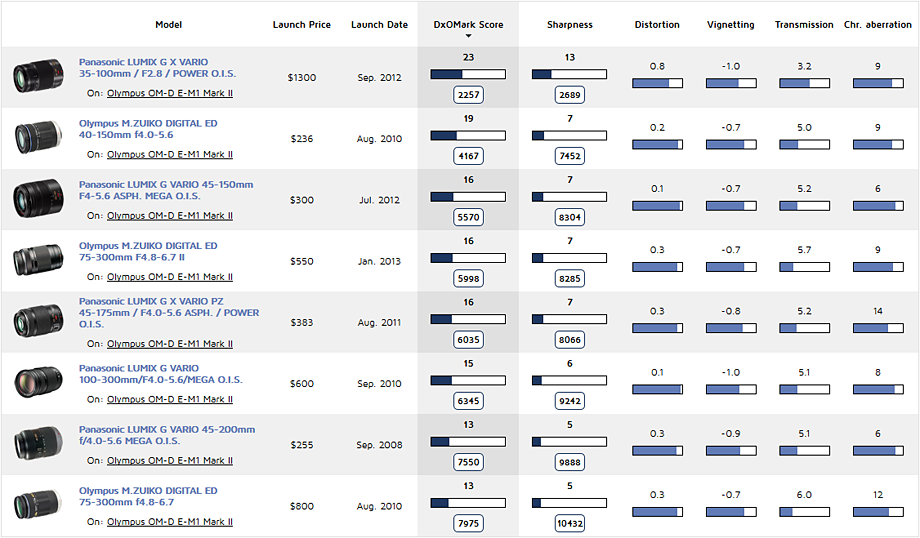
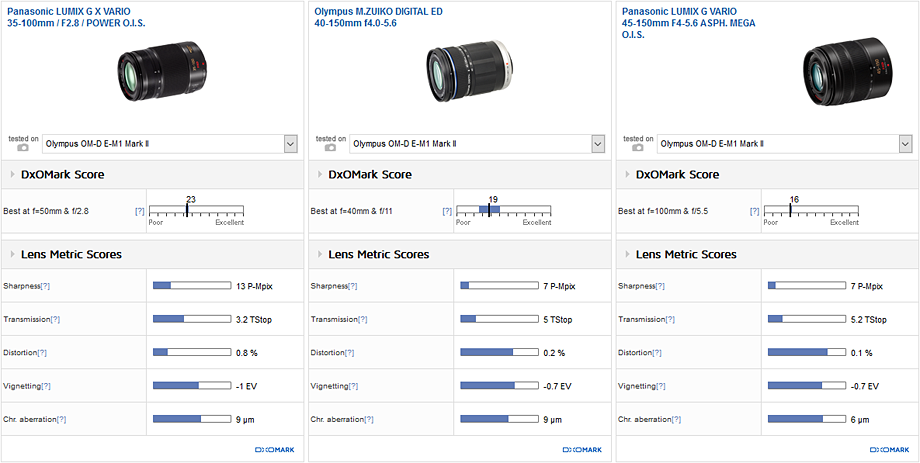
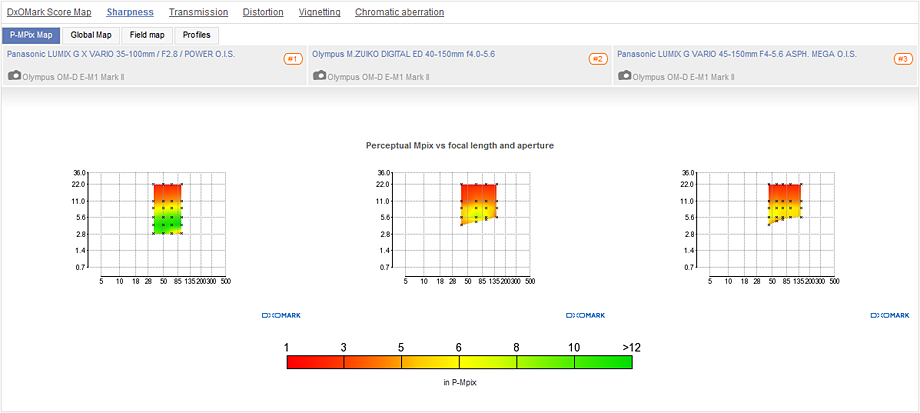
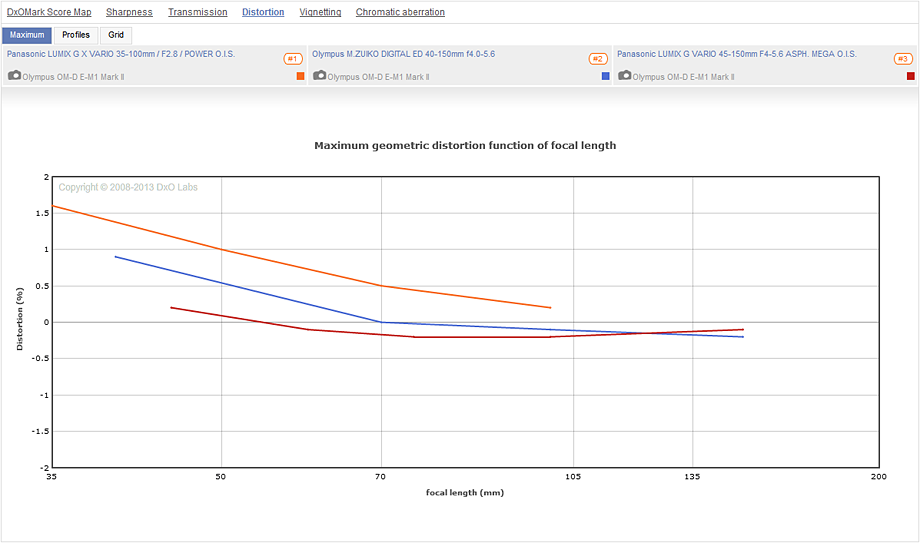

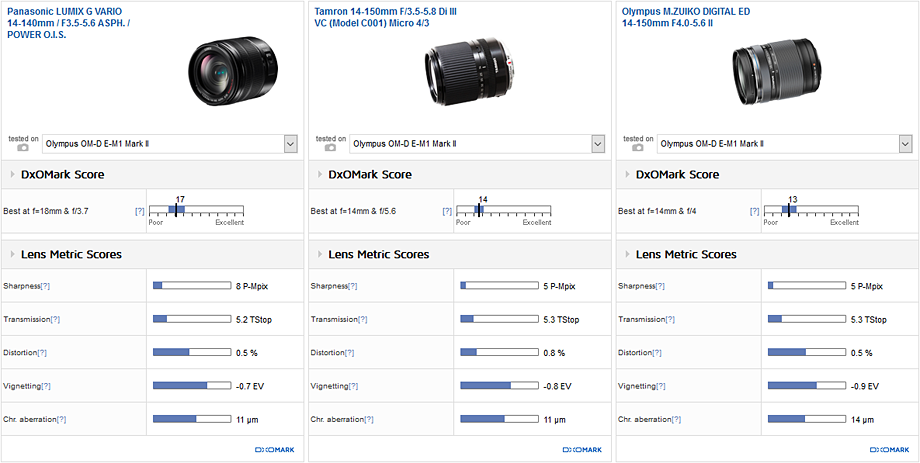
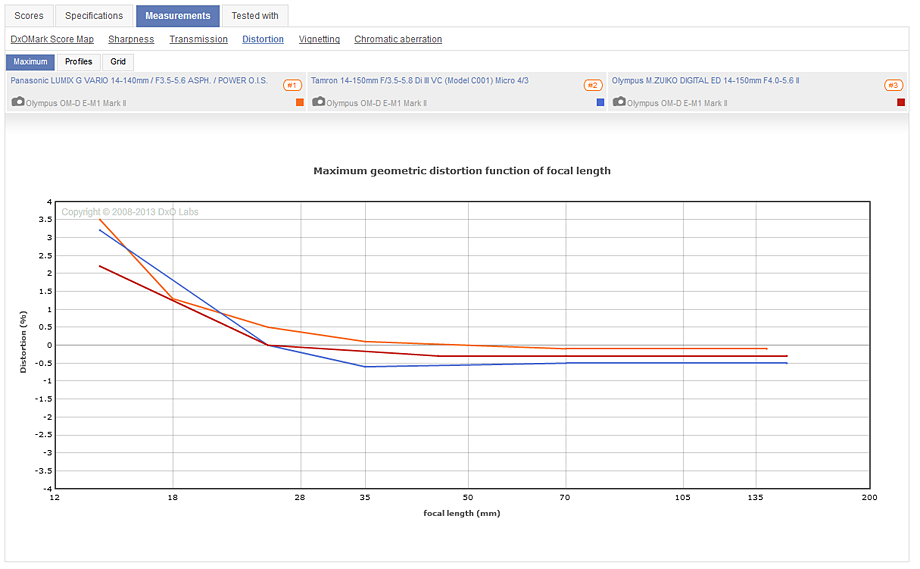
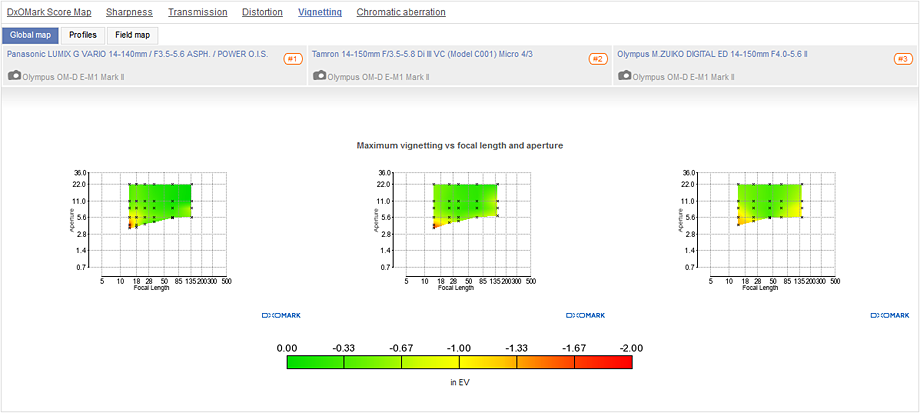
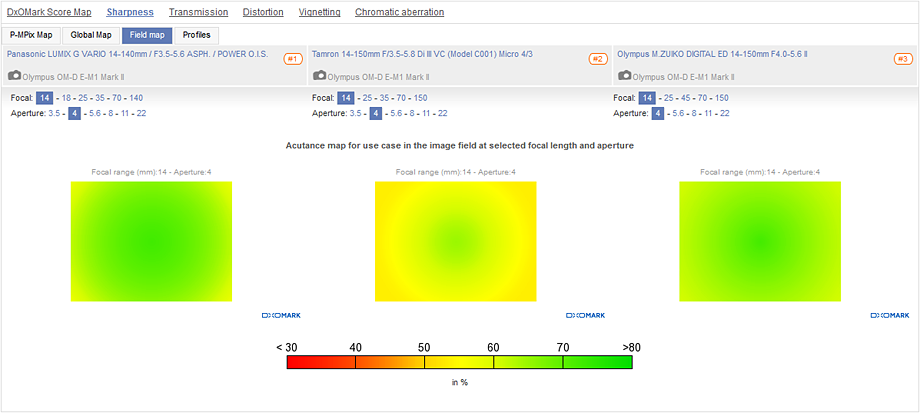
DXOMARK encourages its readers to share comments on the articles. To read or post comments, Disqus cookies are required. Change your Cookies Preferences and read more about our Comment Policy.